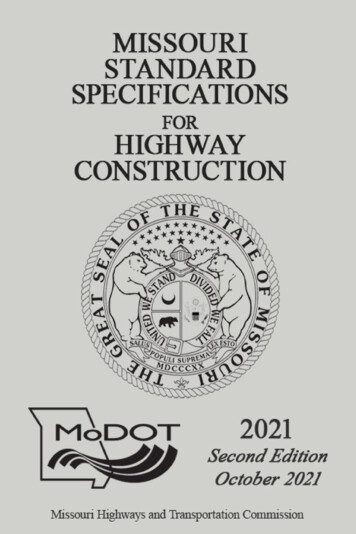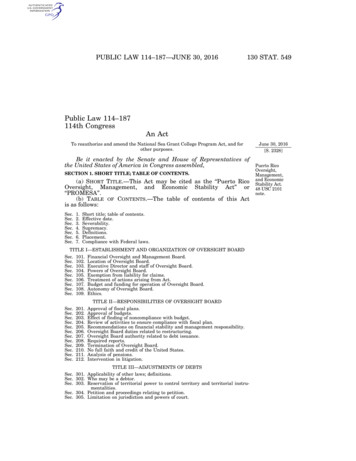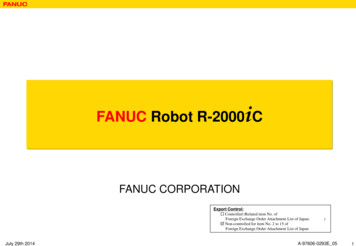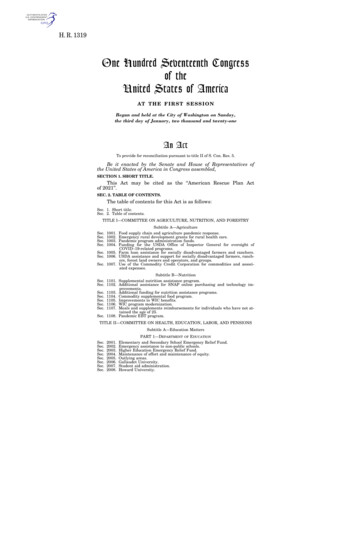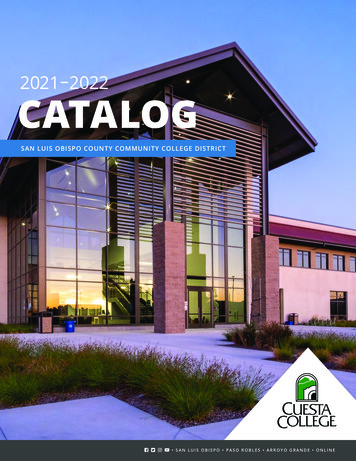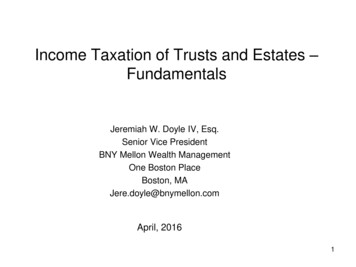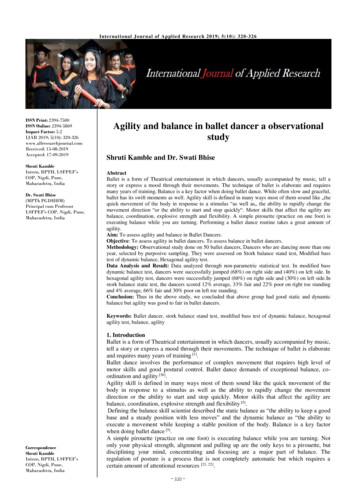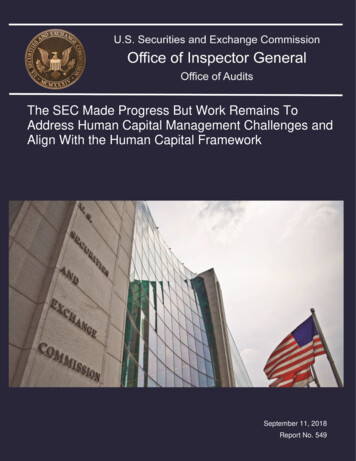
Transcription
U.S. SECURITIES AND EXCHANGE COMMISSIONOFFICE OF INSPECTOR GENERALThe SEC Made Progress But Work Remains ToAddress Human Capital Management Challenges andAlign With the Human Capital FrameworkSeptember 11, 2018Report No. 549
UNITED STATESSECURITIES AND EXCHANGE COMMISSIONWASHINGTON, D.C. 20549OFFICE OFINSPECTOR GENERALM EM O R AN D U MSeptember 11, 2018TO:Jamey McNamara, Acting Chief Human Capital Officer, Office of HumanResourcesFROM:Carl W. Hoecker, Inspector GeneralSUBJECT: The SEC Made Progress But Work Remains To Address Human CapitalManagement Challenges and Align With the Human Capital Framework, ReportNo. 549Attached is the Office of Inspector General (OIG) final report detailing the results of ourevaluation of the U.S. Securities and Exchange Commission’s (SEC or agency) progress toaddress human capital management challenges and align with the Office of PersonnelManagement’s Human Capital Framework. The report contains nine recommendations thatshould help the SEC further address human capital management challenges, better align withHuman Capital Framework, and further improve the SEC’s human capital operations.On August 28, 2018, we provided management with a draft of our report for review andcomment. In its September 7, 2018, response, management concurred with ourrecommendations. We have included management’s response as Appendix III in the finalreport.Within the next 45 days, please provide the OIG with a written corrective action plan thataddresses the recommendations. The corrective action plan should include information suchas the responsible official/point of contact, timeframe for completing required actions, andmilestones identifying how the agency will address the recommendations.We appreciate the courtesies and cooperation extended to us during the evaluation. If youhave questions, please contact me or Rebecca L. Sharek, Deputy Inspector General forAudits, Evaluations, and Special Projects.Attachmentcc:Jay Clayton, ChairmanLucas Moskowitz, Chief of Staff, Office of Chairman ClaytonSean Memon, Deputy Chief of Staff, Office of Chairman ClaytonPeter Uhlmann, Managing Executive, Office of Chairman ClaytonKara M. Stein, CommissionerRobert Peak, Advisor to the Commissioner, Office of Commissioner SteinRobert J. Jackson Jr, CommissionerCaroline Crenshaw, Counsel, Office of Commissioner Jackson
Mr. McNamaraSeptember 11, 2018Page 2Prashant Yerramalli, Counsel, Office of Commissioner JacksonHester M. Peirce, CommissionerJonathan Carr, Counsel, Office of Commissioner PeirceElad Roisman, CommissionerRobert B. Stebbins, General CounselRick Fleming, Investor AdvocateJohn J. Nester, Director, Office of Public AffairsBryan Wood, Director, Office of Legislative and Intergovernmental AffairsKenneth Johnson, Chief Operating OfficerDennis Truskey, Acting Deputy Chief Human Capital OfficerJulie Erhardt, Acting Chief Risk Officer, Office of the Chief Operating Officer
U.S. SECURITIES AND EXCHANGE COMMISSIONExecutive SummaryOFFICE OF INSPECTOR GENERALThe SEC Made Progress But Work RemainsTo Address Human Capital ManagementChallenges and Align With the Human CapitalFrameworkReport No. 549September 11, 2018Why We Did This EvaluationWhat We FoundAccording to the GovernmentAccountability Office’s (GAO) Standards forInternal Control in the FederalGovernment, effective management of anentity’s workforce, its human capital, isessential to achieving results and animportant part of internal control. In theFebruary 2017 update to its High-RiskSeries, GAO again recognized StrategicHuman Capital Management as a high-riskarea needing attention by Congress andthe executive branch. In 2016 and 2017,GAO and the U.S. Securities andExchange Commission (SEC or agency)Office of Inspector General (OIG) identifiedissues related to the SEC’s management ofhuman capital and, in 2017, the SEC OIGreported that Ensuring Effective HumanCapital Management was once again anagency management and performancechallenge. We conducted this evaluationto determine the SEC’s progress towardaddressing its human capital managementchallenges.The SEC’s Office of Human Resources (OHR) has taken steps to addressthe human capital management challenges the agency faces. Amongother things, OHR worked to identify competency gaps and addresssuccession planning, conducted quality of new hire surveys and annualhuman capital reviews, began developing a workforce dashboard, andimplemented various quality assurance reviews.What We RecommendedWe made nine recommendations includingthat OHR finalize competency surveys,finalize standard operating procedures forthe agency’s performance managementprogram, complete regular reviews of itsaccountability system, continue followingup on and, as necessary, closingrecommendations from Policy andAccountability Branch evaluations,formalize internal quality reviewprocedures, and better implement HRStat.Management concurred with therecommendations, which will be closedupon completion and verification ofcorrective action.Although the SEC has made progress, we identified limitations and delaysin OHR’s efforts and additional challenges and opportunities forimprovement. Specifically, the SEC: has faced delays in identifying competency gaps, and limitations inefforts to develop a plan to fill supervisory positions; lacks a formal succession plan; and lacks periodic validations of the agency’s current performancemanagement system and related standard operating procedures.Many of these issues resulted from delays in agreements with the NationalTreasury Employees Union.Also, while it appears that additional controls implemented since our 2016audit of the SEC’s hiring practices have helped to improve the accuracy ofthe SEC’s Workforce Transformation and Tracking System data, OHRcould maintain more detailed hiring action information in the system toexplain inconsistencies in the data when they occur. In addition, OHR mayhave opportunities to improve hiring processes to better meet its hiringtimeframes.OHR has also taken steps to align with the Office of PersonnelManagement’s (OPM) Human Capital Framework (HCF). Among otherthings, OHR drafted updates to agency regulations and procedures,developed a Human Capital Operating Plan, cross-walked its humancapital programs to the HCF, and identified relevant performance metrics.However, work remains to align with OPM’s HCF, which will furtherimprove the SEC’s human capital operations. Specifically, in addition tothe work that remains related to competency assessments, successionplanning, and performance management, OHR’s internal evaluationsystem needs improvement. OHR had not: prioritized elements of its independent audit program, formalized its internal quality review procedures, or implemented HRStat processes for human capital programs.Finally, we surveyed OHR and SEC divisions, offices, and regional officeson areas of OPM’s HCF that correlate to the agency’s previously identifiedhuman capital management challenges. We encourage OHR to exploresignificant differences in survey responses, and address the four areas inwhich OHR acknowledged that additional work is needed to fully align withcorresponding aspects of the HCF.For additional information, contact the Office of Inspector General at(202) 551-6061 or http://www.sec.gov/oig.i
U.S. SECURITIES AND EXCHANGE COMMISSIONOFFICE OF INSPECTOR GENERALTABLE OF CONTENTSExecutive Summary . iBackground and Objectives . 1Background .1Objectives .3Results . 4Finding 1. OHR Has Made Progress But Its Efforts May Not Position the Agency ToFully Remedy Human Capital Management Challenges .4Recommendations, Management’s Response, and Evaluation of Management’sResponse .14Finding 2. Additional Work Is Needed To Align With OPM’s HCF .16Recommendations, Management’s Response, and Evaluation of Management’sResponse .21Other Matters of Interest. 23Figures and TablesFigure 1. Structure of OPM’s HCF .1Figure 2. SEC Division, Office, and Regional Office Responses to OIG SurveyQuestion A.1.10Figure 3. SEC Division, Office, and Regional Office Responses to OIG SurveyQuestion A.4.10Table 1. Analysis of WTTS Data.12Table 2. Summary of Policy and Accountability Branch Program EvaluationRecommendations (as of April 2018) .19Figure 4. SEC Division, Office, and Regional Office Responses to OIG SurveyQuestion A.2.23Figure 5. SEC Division, Office, and Regional Office Responses to OIG SurveyQuestion A.6.24Figure 6. SEC Division, Office, and Regional Office Responses to OIG SurveyQuestion C.3.24AppendicesAppendix I. Scope and Methodology .26Appendix II. Summary of Survey Results.29Appendix III. Management Comments .34REPORT NO. 549iiSEPTEMBER 11, 2018
U.S. SECURITIES AND EXCHANGE COMMISSIONOFFICE OF INSPECTOR OPMSEC or agencySECRSLCWTTSREPORT NO. 549fiscal yearGenerally Accepted Government Auditing StandardsU.S. Government Accountability OfficeHuman Capital FrameworkHuman Capital Strategy Groupnon-bargaining unitNational Treasury Employees UnionOffice of Human ResourcesOffice of Inspector GeneralOffice of Personnel ManagementU.S. Securities and Exchange CommissionSEC Administrative RegulationService Level CommitmentWorkforce Transformation and Tracking SystemiiiSEPTEMBER 11, 2018
U.S. SECURITIES AND EXCHANGE COMMISSIONOFFICE OF INSPECTOR GENERALBackground and ObjectivesBackgroundFederal Human Capital Management. Human capital management has been thesubject of attention across the Federal Government. In the February 2017 update to itsHigh-Risk Series, the U.S. Government Accountability Office (GAO) again recognizedStrategic Human Capital Management as a high-risk area needing attention byCongress and the executive branch. GAO’s Standards for Internal Control in theFederal Government (GAO’s Internal Control Standards) further reiterates that effectivemanagement of an entity’s workforce, its human capital, is essential to achieving resultsand an important part of internal control. 1 To assist agencies in addressing humancapital management challenges, the Office of Personnel Management (OPM) hasestablished tools and issued guidance. For example, in December 2016, OPMintroduced a new Human Capital Framework (HCF) to provide comprehensive guidanceon the principles of strategic human capital management in the Federal Government.As Figure 1 shows, OPM’s HCF integrates the following four human capital systems:(1) Strategic Planning and Alignment, (2) Talent Management, (3) Performance Culture,and (4) Evaluation. 2 Within each system, OPM defined focus areas and key elementsfor agencies to consider when designing and implementing the systems.Figure 1. Structure of OPM’s HCFSource: OPM Human Capital Management website, accessed on June 28, 2018.1U.S. Government Accountability Office, Standards for Internal Control in the Federal Government (GAO14-704G, September 2014).2See Personnel Management in Agencies, 81 Fed. Reg. 89357 (December 12, 2016) (revising 5 C.F.R.Part 250, Subpart B).REPORT NO. 5491SEPTEMBER 11, 2018
U.S. SECURITIES AND EXCHANGE COMMISSIONOFFICE OF INSPECTOR GENERALHuman Capital Management at the SEC. The U.S. Securities and ExchangeCommission’s (SEC or agency) Office of Human Resources (OHR) provides leadershipfor the agency’s strategic management of human capital by administering programs,establishing policies, and ensuring compliance with applicable Federal regulations.According to SEC Administrative Regulation (SECR) 6-49, Human CapitalAccountability System, (SECR 6-49) effective September 2016, it is the policy of theSEC to establish and maintain an accountability system to monitor and analyze SECperformance on all aspects of human capital management policies, programs, andactivities. SECR 6-49 also requires that the SEC establish activities to ensure it is ableto accomplish its mission and ensure compliance with merit system principles and otherapplicable civil service laws, regulations, and policies.In 2016 and 2017, the SEC made some improvements to its human capitalmanagement program, including the agency’s Aspiring Leaders Program (intended topromote and build leadership competencies of senior employees) and development ofthe agency’s first Strategic Workforce Plan. In addition, the SEC developed a HumanCapital Strategic Plan for fiscal years (FYs) 2016 through 2018 to ensure the agencyaddresses human capital challenges as a core part of ongoing organizationaltransformation efforts. Although implementing Federal regulations for OPM’s HCF (5CFR Part 250, Subpart B, Strategic Human Capital Management) apply only to ChiefFinancial Officers Act agencies (which do not include the SEC), the SEC is transitioningaspects of the agency’s human capital management strategy to align with OPM’s HCFguidance.SEC OIG and GAO Reviews. The SEC’s human capital management programs,including hiring and competency assessments, workforce and succession planning, andperformance management have been the subject of report findings issued by the SEC’sOffice of Inspector General (OIG) and GAO.Prior OIG Review. In October 2017, the SEC OIG again identified EnsuringEffective Human Capital Management as an agency management and performancechallenge. 3 Specifically, we reported that OHR did not have an effective method forassessing the timeliness of the SEC’s hiring process, including maintaining reliablehiring data and monitoring hiring actions according to established timelines.Furthermore, OHR did not analyze quality-of-new-hire survey results to improve theSEC’s hiring process. We urged OHR to implement an effective system based onreliable data to conduct comprehensive assessments of the SEC’s hiring process,further improve the agency’s hiring process, and increase the likelihood that SECdivisions and offices timely hire highly-qualified candidates to meet missionrequirements. 43U.S. Securities and Exchange Commission, Office of Inspector General, The Inspector General’sStatement on the SEC’s Management and Performance Challenges, October 2017 (October 5, 2017).4U.S. Securities and Exchange Commission, Office of Inspector General, Final Closeout Memorandum:Audit of the SEC’s Hiring Practices (August 19, 2016).REPORT NO. 5492SEPTEMBER 11, 2018
U.S. SECURITIES AND EXCHANGE COMMISSIONOFFICE OF INSPECTOR GENERALPrior GAO Reviews. In addition, in December 2016, GAO issued its secondtriennial report on the SEC’s personnel management 5 required under the Dodd-FrankWall Street Reform and Consumer Protection Act. 6 In its 2016 report, GAO indicatedthat the SEC had addressed two of seven recommendations from GAO’s 2013 report.At the time of our evaluation, GAO had closed a third recommendation from its 2013report related to identifying and implementing incentives for all staff to support opencommunication and collaboration, yet four 2013 recommendations remained open.These recommendations related to workforce and succession planning, formal actionplans for identifying and closing competency gaps and filling supervisory positions,periodic validations (with staff input) of the agency’s performance management system,and exploring and implementing communication and collaboration best practices.In addition to the open recommendations from 2013, in 2016 GAO reported that theSEC faced added challenges in cross-divisional collaboration and hiring and promotion.GAO also found that, because the SEC had not identified skills gaps among its hiringspecialists, its training of these staff was limited. As a result, GAO concluded that theSEC lacked assurance that its hiring specialists had the necessary skills to hire andpromote the most qualified applicants, in accordance with key principles of an effectivecontrol system.ObjectivesOur overall objective was to evaluate the SEC’s progress toward addressing humancapital management challenges. Specifically, we assessed the SEC’s implementationof applicable Federal internal control standards and plans for aligning the agency’shuman capital management strategy with key elements of OPM’s HCF to addresshuman capital management challenges the SEC faces.To address our objectives, among other things, we interviewed OHR, OPM, and GAOofficials; reviewed SEC hiring data from October 1, 2016, through May 31, 2018;requested that OHR leadership complete an OPM diagnostic tool; and surveyed SECdivisions, offices, and regional offices—with the exception of the OIG—on select areasof OPM’s HCF. Appendices I and II include additional information about our objectives,scope, and methodology; our review of relevant Federal regulations and guidance, SECpolicies and procedures, and internal controls; prior coverage; and the results of oursurvey of SEC management.5U.S. Government Accountability Office, Securities and Exchange Commission, Actions Needed toAddress Limited Progress in Resolving Long-Standing Personnel Management Challenges (GAO-17-65,December 2016).6Public Law 111-203, H.R. 4173.REPORT NO. 5493SEPTEMBER 11, 2018
U.S. SECURITIES AND EXCHANGE COMMISSIONOFFICE OF INSPECTOR GENERALResultsFinding 1. OHR Has Made Progress But Its Efforts May Not Positionthe Agency To Fully Remedy Human Capital Management ChallengesThe SEC’s OHR has taken steps to address the human capitalmanagement challenges the agency faces. As part of these efforts, OHRestablished projects to address agency priorities in identifying competencygaps and succession planning. To further help with identifyingcompetency gaps, OHR conducted surveys to measure the overall qualityof new hires, annual human capital reviews with each division and office,and a skills gap analysis and training specifically for hiring specialists. Tohelp with succession planning and to give agency divisions and officesreal-time human capital data for analyzing workforce supply and demand,OHR began developing a workforce dashboard. OHR also developedchecklists to improve the accuracy and completeness of agency hiringdata and case files, and implemented case file quality assurance reviews.Finally, to monitor the timeliness of hiring, OHR implemented quarterlyreviews of all hiring actions.Although the SEC has made progress, we identified limitations in OHR’sefforts and additional challenges and opportunities for improvement.Specifically, the SEC: has faced delays in identifying competency gaps and limitations inefforts to develop a plan to fill supervisory positions; lacks a formal succession plan; and lacks periodic validations of the agency’s current performancemanagement system and related standard operating procedures.Many of these delays and limitations have resulted from delays inagreements with the National Treasury Employees Union (NTEU).In addition, although it appears that additional controls implemented sinceour 2016 audit of the SEC’s hiring practices have helped to improve theaccuracy of the SEC’s Workforce Transformation and Tracking System(WTTS) data, OHR could maintain more detailed hiring action informationin WTTS to explain inconsistencies in the data when they occur. Also,based on OHR’s quarterly reviews of WTTS data, OHR may haveopportunities to improve hiring processes to better meet its Service LevelCommitment (SLC) hiring timeframes. Each of these topics is discussedin greater detail below.REPORT NO. 5494SEPTEMBER 11, 2018
U.S. SECURITIES AND EXCHANGE COMMISSIONOFFICE OF INSPECTOR GENERALDelays in Identifying Competency Gaps and Limitations in Efforts To Develop aPlan To Fill Supervisory Positions. According to OPM’s HCF, agencies shoulddevelop policies and programs that monitor and address skills gaps by usingcomprehensive data analytic methods and gap closure strategies. The HCF also statesagencies should develop policies and programs that ensure leadership continuity byimplementing and evaluating recruitment, development, and succession plans forleadership positions. Finally, GAO’s Internal Control Standards require that agencymanagement demonstrate a commitment to recruit, develop, and retain competentindividuals.Although OHR began an agency-wide competency assessment project in 2016 with theintention of helping identify competency gaps and strategies to address them, delays inagreements with the NTEU have delayed the agency’s ability to identify competencygaps. In addition, the work the agency has completed to date does not address GAO’sconcerns regarding a formal action plan to fill supervisory positions 7 and does not fullymeet OPM’s HCF guidance regarding leadership continuity.Delays in Identifying Competency Gaps. To date, OHR has: (1) conductedfocus groups to gather feedback for an agency-wide launch of a competency survey;(2) developed competency assessment surveys for employees, managers, and seniorofficers to complete; (3) met with NTEU to develop appropriate messaging toemployees and to include manager feedback; (4) finalized agency communications anda competency job aid; and (5) tested the core competency and technical competencysurveys in the live system to address any system concerns. The competencyassessment surveys OHR developed are intended to assess technical competencies forthe SEC’s five mission critical positions8 and hiring specialists, competencies for agencymanagers and senior officers, and core competencies for all employees. 9The competency assessment project’s estimated completion date is September 2018.However, as of July 2018, OHR had not initiated the employee survey because thememorandum of understanding with NTEU was not finalized. OHR officials explained7In 2013, GAO recommended that, to enhance the SEC’s ability to strategically hire and retain theappropriate number of staff with the requisite skill sets for today and in the future, the SEC Chairmanshould direct the Chief Operating Officer and OHR to incorporate OPM guidance as the agencydeveloped its workforce and succession plans, by developing a formal action plan to identify and closecompetency gaps, and fill supervisory positions; and institute a fair and transparent process for identifyinghigh-potential leaders within the agency.8The SEC’s five mission critical positions are: (1) attorneys, (2) accountants, (3) economists,(4) examiners, and (5) information technology specialists.9According to OHR personnel, there are four tiers of surveys. All employees will receive a corecompetency survey (tier 1). Employees in one of the five mission critical positions and hiring specialistswill receive the core competency survey and a technical competency survey (tier 2), depending on theirposition. Managers will receive the core competency survey, technical competency survey, asappropriate, and the manager survey (tier 3). Senior officers will receive the core competency survey,technical competency survey, as appropriate, the manager survey, and a senior officer survey (tier 4).REPORT NO. 5495SEPTEMBER 11, 2018
U.S. SECURITIES AND EXCHANGE COMMISSIONOFFICE OF INSPECTOR GENERALthat delays occurred throughout the process because NTEU disagreed with some of thesurvey questions and the survey format. 10 OHR was also delayed in finalizing themanager survey because of possible NTEU changes to the employee survey. Inaddition, while OHR plans to conduct competency assessments on a recurring basis,OHR had not established a formal plan to do so.According to an OHR official, OHR could survey SEC employees and managers withoutNTEU’s approval or a signed memorandum of understanding with the union. However,the official preferred to obtain NTEU approval to avoid any potential negative impacts tothe survey results. In addition, OHR could limit the agency’s competency assessmentsurveys to only non-bargaining unit (NBU) staff. However, doing so would allow OHR tosurvey only about 26 percent of SEC employees. 11By not completing competency assessment surveys, or other similar comprehensivereviews, OHR may be limited in its ability to effectively identify, monitor, and addressskills gaps, therefore potentially limiting the agency’s ability to develop individuals. Bynot establishing a formal plan for completing future competency assessments, the SECrisks being unable to adequately plan future workforce needs. In addition, we surveyedthe SEC’s divisions, offices, and regional offices and found that 24 of 32 (or 75 percent)of the divisions and offices that responded indicated that they have, or at one point had,staffing and competency gaps. Although 17 of those 24 respondents (or about71 percent) indicated that the agency worked to close such gaps, the remaining7 divisions and offices indicated that the agency either had not worked to close theirstaffing and competency gaps or that they were unaware whether the agency hadworked to close such gaps. Without a competency survey and a formal plan forcompleting future competency assessments, OHR risks being unable to fully and timelyassist the SEC’s divisions, offices, and regional offices in identifying and closing skillsand competency gaps.Limitations in Efforts To Develop a Plan To Fill Supervisory Positions. As part ofthe succession planning project discussed further below, in 2017 OHR surveyed firstand second-level managers (SK-15s and SK-17s) and found no shortage of candidatesinterested in SEC leadership positions. However, although SEC first- and second-levelmanagers may be candidates to fill executive leadership (that is, senior officer) positionsand may have insight into non-managerial staff’s interest in leadership positions,surveying managers alone may be of limited use. Moreover, the work completed todate does not address GAO’s concerns regarding a formal action plan to fill supervisorypositions, and does not fully meet OPM’s HCF guidance regarding leadership continuity.OHR officials plan to survey all SEC employees in the future. However, OHR officialsexplained that they have not yet surveyed all SEC employees because of the need to10In August 2018, OHR officials indicated that NTEU signed off on the survey questions, survey format,and memorandum of understanding.11NTEU represents about 74 percent of SEC employees.REPORT NO. 5496SEPTEMBER 11, 2018
U.S. SECURITIES AND EXCHANGE COMMISSIONOFFICE OF INSPECTOR GENERALinvolve NTEU in the survey development and administration processes. Because theSEC has not completed surveys of SK-14s and below and has not developed the formalaction plan recommended by GAO, the agency risks being unable to ensure leadershipcontinuity. Because of GAO’s open recommendation, we are not making an additionalrecommendation in this area.Lack of a Succession Plan. According to OPM, succession planning forms an integralpart of workforce planning and helps ensure an ongoing supply of qualified staff to fillleadership and other key positions. Specifically, 5 CFR Part 412 requires that the headof each agency, in consultation with OPM, develop a comprehensive managementsuccession program, based on the agency's workforce succession plans, to fill agencysupervisory and managerial positions. 5 CFR Part 412 also requires that agencysuccession programs be supported by employee training and development programs.To help with succession planning, OHR developed a Strategic Workforce Plan forFYs 2016 through 2018, which included a succession planning section that definedsuccession planning as “a systematic approach to build leadership pipelines/talent poolsto ensure leadership continuity and to develop potential successors in ways that best fittheir strengths.” The plan also identified competencies and training courses required foreach leadership level.OHR also initiated a succession planning project to help identify the most critical needswith regard to vacancies in leadership positions and to ensure there are availableinternal resources to fulfill those needs, when necessary. In conjunction with thisproject, OHR benchmarked other agencies’ succession planning strategies and foundthat many agencies lacked a succession plan. 12 However, the SEC adopted a strategyused by the Federal Deposit Insurance Corporation. As previously stated, as part of thestrategy, OHR surveyed managers (SK-15s and SK-17s) to determine interest inleadership positions and concluded that there was enou
Federal Human Capital Management. Human capital management has been the subject of attention across the Federal Government. In the February 2017 update to its High-Risk Series, the U.S. Government Accountability Office (GAO) again recognized Strategic Human Capital Management as a high-risk area needing attention by Congress and the executive .


